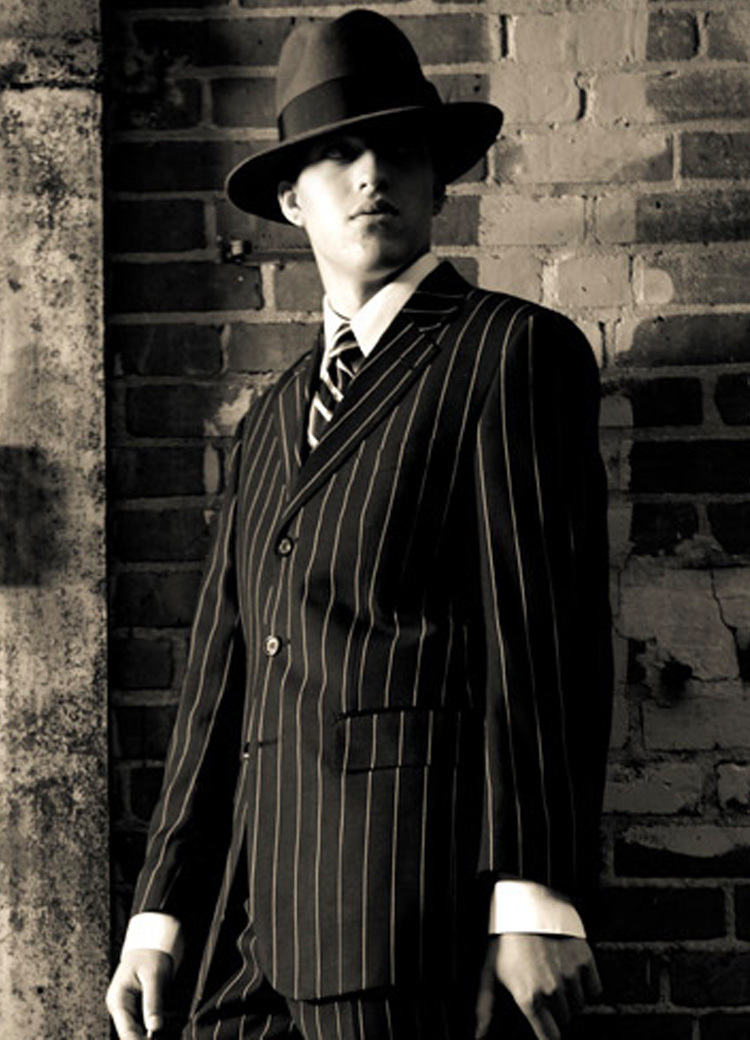Bank robbers, G-Men & 1937 Topeka shoot out
On April 16, 1937, two fugitive bank robbers and three G-Men met at the Topeka post office at 4th and Kansas. What happened in those few minutes became national news in big, bold headlines:
- Los Angeles Daily News: G-Man Shot Down as Bandits Flee Federal Trap
- Topeka Daily-Capital: Bandits Shoot G-Man; Captured in Nebraska
- New York Times: Killers of G-Man Doomed to Gallows
- Fort Worth Star-Telegram: Pair Die On Gallows for Death of G-Man
G-Men?
If you haven't watched 1930s gangster movies, G-Men meant government men. Prior to 1935, a G-Man was slang for anyone who worked for the federal government. However, in September of 1935 the FBI went to arrest George Machine Gun Kelly. He came out with his hands up yelling &Don't shoot G-Men, Don't Shoot! From that time on, or so the story goes, G-Men referred only to FBI special agents.
One such G-Man was Wimberly Wayne Baker. He was intelligent, clean-cut and athletic. Baker had some experience as a sheriff, in his hometown of Yuma, Arizona. He went on to clerk for the FBI, for about a year, while he earned his law degree in 1936. The FBI assigned Baker to the Kansas City office, and the Topeka stakeout was his first major assignment as a special agent.
Roots of Topeka shoot out
The story of the Topeka shooting starts in Katonah, New York, in March 1937. Robert Suhay and Glen John Applegate robbed the Northern Westchester Bank of Katonah of $18,000. In the first articles about the robbery, Applegate had aliases and it took about a month after the shooting to get his real name. Authorities arrested the duo's accomplices in the New York area. Suhay and Applegate went on the run.
Outlaws vs. G-Men
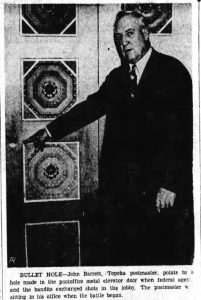 The FBI received a tip that the fugitives might be going to the post office in Topeka to pick up mail. Special agents Baker, James Foreland and Roy Martin were assigned to set a trap for the robbers. The agents watched the post office for three days.
The FBI received a tip that the fugitives might be going to the post office in Topeka to pick up mail. Special agents Baker, James Foreland and Roy Martin were assigned to set a trap for the robbers. The agents watched the post office for three days.
On April 16, 1937, Baker and Martin stood guard, while Foreland went across the street for a late breakfast. Around 11am, Baker saw Applegate walk up to the window to get his mail. Baker approached him and told him to put his hands up not knowing Suhay was coming up behind him. Suhay shot Baker multiple times.
Chaos erupted. Martin returned fire. Two bystanders were slightly injured as they dove for cover. The bandits continued firing while running across Kansas Ave to their car parked near the New England Building at 501 S Kansas Ave. The fugitives jumped in their black Buick coupe, went west on 5th Street and got away.
Battle continues out of town
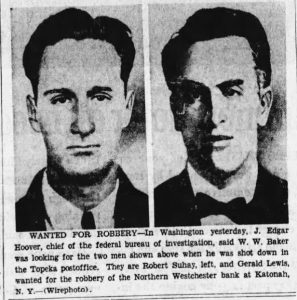 Suhay and Applegate crossed the Kansas river headed toward Rossville. They traveled to Sabetha where they kidnapped a doctor to treat Suhay’s gunshot wound. The Kansas Highway Patrol tracked them by radio, a relatively new technology in 1937, and knew they were headed for the Nebraska state line. Suhay and Applegate were at large for about 10 hours. A small county sheriff in Nebraska, Homer Sylvester, arrested them without firing a shot.
Suhay and Applegate crossed the Kansas river headed toward Rossville. They traveled to Sabetha where they kidnapped a doctor to treat Suhay’s gunshot wound. The Kansas Highway Patrol tracked them by radio, a relatively new technology in 1937, and knew they were headed for the Nebraska state line. Suhay and Applegate were at large for about 10 hours. A small county sheriff in Nebraska, Homer Sylvester, arrested them without firing a shot.
Injured G-Man
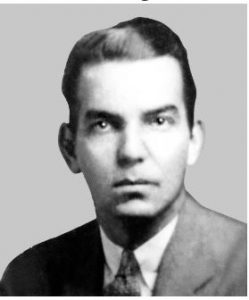
Special Agent Baker
Responders took agent Baker to Topeka's St. Francis Hospital in grave condition. The newspapers reported rumors he was not expected to live, but the FBI shut off all communication between the hospital and the press. Baker died on Saturday night, April 17. However, the FBI didn't release news of his death until Sunday afternoon.
Hoover, ordered complete secrecy. He later said he withheld the information so the fugitives wouldn't know they were wanted for murder. Local authorities were angry that the FBI came into the community and set up an ambush without notifying local law enforcement.
Press criticizes FBI
The newspapers had a field day writing critical articles and editorials on the FBI&'s failure to capture the bad guys. In an editorial in the Topeka Daily-Capital titled For Land's Sake Mr. Hoover, Be Careful, the writer crowed about how a country officer bagged the gangsters after the G-Men failed. He went on to complain that the FBI's failure to alert the local police needlessly put the populace in jeopardy. The editorial ended with: Local officials may lack the finesse of the highly trained G-Men, but they often capture their quarry without shooting up the town.
The Topeka State Journal was equally scathing in its editorial - A Sheriff Captures Them. It criticized the FBI's withholding information from local officers, commenting that a local officer with no Washington notions captured the outlaws. The writer called into question the wisdom of using an inexperienced agent (Baker). Papers also criticized the secrecy surrounding Baker's condition.
J. Edgar Hoover was furious with the criticism. In an angry rebuttal, Hoover said the criticism of the FBI was unwarranted and untrue. W. H. Drane Lester, Hoover’s assistant, went further and said, “If we had had the National Guard and all local police there too, it’s my opinion that we couldn’t have saved Baker’s life.” He also tried to correct the impression that Baker was inexperienced even though this was his first assignment.
Lost in the sniping between local officials and the FBI, was the fact that a young man was dead. Baker's father and brother escorted his body home to Yuma, Arizona. Dignitaries including state and local leaders attended his funeral service.
Bringing fugitives to justice
The FBI held the fugitives in Kansas City, Missouri, while they waited to be charged. The court system wasted no time bringing them to trial. The trial began June 21, 1937. The judge found Applegate and Suhay guilty of murdering a federal agent. On June 27, 1937, they were given the death penalty. Appeals were denied and both men were hanged at Leavenworth Penitentiary, August 12, 1938.
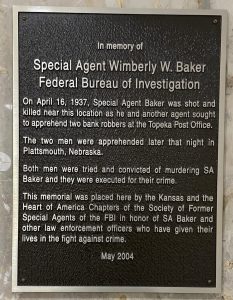 Newspapers all over the country reported this crime following every detail for more than a year. There wasn't a 24-hour news cycle in those days, but reporters shared information. The same article, reporting the previous day's events, appeared in the daily papers from Maine to California.
Newspapers all over the country reported this crime following every detail for more than a year. There wasn't a 24-hour news cycle in those days, but reporters shared information. The same article, reporting the previous day's events, appeared in the daily papers from Maine to California.
If you go to the downtown post office today, you will see a mark on the wall made by a bullet fired during the attempted capture of the two New York fugitives. The bullet hole in the elevator door is no longer visible. Next to the elevator is a plaque dedicated to Special Agent Baker commemorating his death in the line of duty.
Doing your own research
The library has multiple resources to dig into local history. The library edition of newspapers.com gives you access to newspapers across the country. I found articles about Wimberly Baker playing baseball, belonging to a university fraternity and the details of his funeral. The Topeka newspapers are digitized through 1922 on newspapers.com and digitized 1999-present on Newsbank. For articles 1923-1998, you can access them on microfilm in the Topeka Room. There isn't an index for the microfilm, so you need a date to start your research.
More resources in the library

Research area of Topeka Room
The library has many old titles of magazines such as Life, Colliers, Saturday Evening Post, and Reader's Digest. The December 1937 issue of Readers Digest has an article about J Edgar Hoover and his requirements for the ideal special agent. If you are interested in reading or researching these magazines while you are in the library, ask any library staff member and we will bring you what you are looking for.
When you think of Ancestry.com, you think of genealogy research. Ancestry.com has other goodies, like a collection of yearbooks from 1900-2016. In the collection there were photos of Special Agent Baker in 1926 at Yuma High School and National University's 1936 yearbook. Ancestry library edition is only available in the library.
The Polk city directory was very helpful in determining the location of Merchants National Bank in 1937. You can find a lot of information in city directories, business information plus residential information such as who lived at a certain address and what their occupation was.
The library and the Topeka Room have fabulous resources for research. Beware, it is easy to fall down a rabbit hole and be sidetracked by an article that has nothing to do with your research, such as the coronation of King VI or the price of a refrigerator in 1937!











